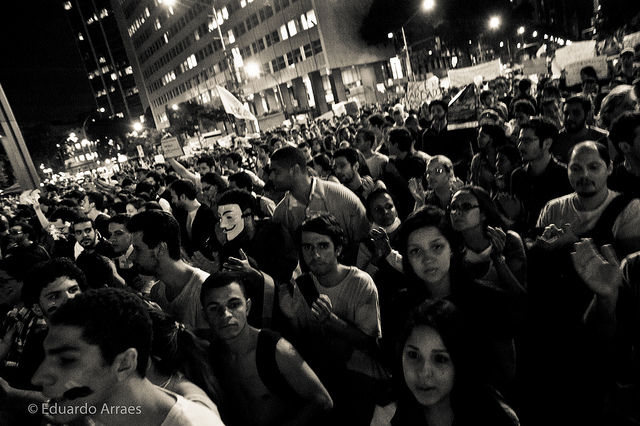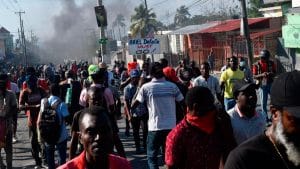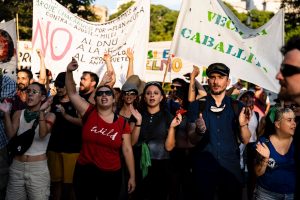Photo: Eduardo Fonseca Arraes.
Nearly a year after the World Cup Final, hundreds of students assembled in the shadow of Rio de Janeiro’s Maracana Stadium to debate a student strike at the State University of Rio de Janeiro (UERJ). Like nearly all of Brazil’s public universities, UERJ is facing a financial crisis that the administration is attempting to resolve through sweeping attacks on the conditions of students and workers.
The students’ strategy discussion was interrupted by the sound of bombs and gunfire coming from the nearby Metro-Mangueira favela, where police were attacking residents trying to prevent the demolition of their homes. The students stopped their assembly and marched out to help the residents shut down the main street between the university and the favela. Police responded by launching tear gas canisters and firing rubber bullets.
Choking on gas, the students retreated and sought sanctuary in the university, only to find the entrance closed and guarded by campus security. A video compiled later by the communications department of the student union shows one student assaulted and dragged off, and many others harassed and violently threatened. After a brief standoff, security brought out fire hoses and blasted protesters off the steps of their own university.
This unprecedented level of repression by the university comes amid a profound crisis in Brazil’s university system. The Workers’ Party (PT) government’s sharp turn towards austerity has transformed Brazil’s universities into one of the most important and potentially explosive sites of resistance.
In recent months professors at twenty-four federal universities have engaged in strike actions, and technical workers have walked out at fifty-eight of sixty-four. Non-union subcontracted workers at universities across the country, after working for months without pay, responded with their own militant strikes. These work stoppages have emerged alongside a wave of student mobilizations, with occupations and strikes at campuses across Brazil.
Since the PT government came to power in 2003, Brazil has seen the largest expansion of the university system in its history. The number of federal universities more than doubled, and the number of students in these college rose from 596,000 to 1 million.
Thanks to an extensive program of grants and student loans, private universities and technical schools experienced an even larger expansion, bringing in millions of students. While the program didn’t challenge the elite character of higher education in Brazil — strict entrance exams remain — the massive growth of the university system alongside the implementation of affirmative action was one of the PT’s most progressive and significant reforms.
The education reforms coincided with rapid economic growth in Brazil, making the enlarged higher education system and new social programs compatible with the interests of business — high growth rates justified the training of a new generation of technicians, engineers, educators, and medics.
However, as Brazil has grappled with the global economic crisis, compounded by a drastic fall in commodity prices and a massive corruption scandal at Petrobras, the PT has moved to restore business confidence with a series of deep cuts. In this climate of economic crisis and uncertainty, the demand for managers, engineers, and technicians has waned alongside capital’s willingness to tolerate the social spending that made the expansion of the Brazilian university system possible.
Despite the political divide between the PT and the Brazilian Social Democracy Party (PSDB), in practice both parties have united behind a program of harsh austerity measures. Each backs deep cuts to social programs, and Brazilian President Dilma Rousseff recently announced a $3.2 billion reduction (or 15%) to the education budget.
Openings in technical higher education programs will be slashed from 3 million to 1 million, and students in for-profit universities (overwhelmingly poorer students unable to enter elite public universities) face the possibility of a major interest rate hike in student loans as well as substantial limits on the availability of loans and government grants.
At federal universities in Rio, students have been forced to have classes outside or are packed into crumbling buildings, and in Brazil’s most expensive city, students are forced to live on grants of about $130 a month — an amount that barely covers the cost of taking public transport to campus.
Brazilian students are now graduating into one of the bleakest job markets in recent history. From 2002–2014 the rate of youth unemployment in major metropolitan areas fell from 23.2% to 11%, but in April of this year that number rose to 16.2%. For students with 11 or more years of school (including advanced degree holders) the rate rose from 11.1% last year to 14.6% this April. Students with degrees in fields like engineering are more likely to find jobs, but often end up working internships that pay barely more than the minimum salary. With private industry and government agencies all announcing cost cuts and layoffs, unemployment is likely to rise.
The PT’s failure to make good on its promises of “social ascension” and its involvement in corruption scandals has destroyed its credibility and thrown the party into a deep political crisis. Rousseff’s approval rating is at a record low of 10%, the lowest in twenty years, with the highest levels of disapproval among youth.
A recent survey showed that two out of three Brazilians have no sympathy for any political party, the highest since 1988, when the current constitutional regime was established. Widespread discontent with the PT and the unsustainability of the economic model that undergirded the compromise between economic growth and social programs is forcing Brazil into a fraught conjuncture where both left and right alternatives have a chance to seize the offensive.
If the present balance of forces continues, the most likely political outcome will be a victory for the Right. The 2014 elections were extremely close (the PT won with 51.6% to Aécio Neves’s PSDB 48.3%), and the electoral strength of the PSDB has positioned them as the most likely to gain from the PT’s declining fortunes.
Earlier this year, hundreds of thousands of Brazilians hit the streets demanding impeachment in protests supported by the national media and dominated by the Right. While the movement for impeachment has mostly disappeared since, the Right remains bolstered.
The weakening of the PT also provides opportunities for the main left opposition party, the Party of Socialism and Freedom (PSOL). Between the 2010 and 2014 elections PSOL doubled its vote from 0.87 to 1.5%, and it has recently had the second highest number of new party members. PSOL itself originated in a left split from the PT and is likely to be the main beneficiary of any left breaks from the PT.
However, the PSOL’s capacity to effectively project a left alternative is questionable. Where the party has won office it has not consistently supported workers’ demands. It is a primarily electoral phenomenon without a solid base in the worker or student movements, and it has not yet shown the kind of electoral strength needed to legitimize itself as a genuine alternative. It is well positioned to gain from any upsurge of resistance, but is more likely to act as a thermometer than a catalyst for the struggle.
The mass protests in June 2013 shook the nation and made world headlines. The demonstrations mobilized millions around Brazil against the mainstream political parties and set off a wave of grassroots worker militancy in which garbage collectors won a 40% pay hike through an illegal wildcat strike.
These protests had a profound politicizing impact on a new generation of Brazilian students. With universities at the center of the present crisis, the student and university labor movements provide one of the best hopes for the emergence of a left alternative.
University and high school students made up much of the militant youth who rallied against bus fare hikes, challenged police in the streets, and rejected the politics of both the governing parties and right-wing opposition. Few students entering university remember a time when the PT did not hold power and are thus willing to hold the PT responsible for the widespread economic inequality, brutal police repression, and elite corruption that continue to dominate Brazil.
So far Rio students have been at the vanguard of the movement leading some of the most radical and publicized actions. Several hundred students at Rio’s federal university occupied the administrative building for over a week and have continued mobilizing since.
Occupations and mobilizations have also taken place at two other federal universities near Rio, and at the more working-class state university, students have continued to hold protests and assemblies of hundreds to coordinate the struggle and try to build a strike. Many students travel two or three hours from the working-class suburbs of Rio to attend classes or participate in the movement.
Yet, while student militancy has emerged locally, it has not been expressed coherently at a national scale. The national student movement is divided into two main organizations. The pro-government National Student Union (UNE) is dominated by parties linked to the PT, with an opposition movement led by organizations affiliated with the PSOL; the anti-government National Assembly of Free Students (ANEL) broke from UNE in 2009 and is led by the Unified Socialist Workers Party (PSTU), with the Revolutionary Workers Movement (MRT) playing an important opposition role.
Both student groups held national conferences earlier this month, but despite militant local mobilizations, attendance was down sharply from previous conferences. The majority of UNE approved a leadership tied to the PT, while the majority of ANEL voted for a general strike but failed to implement a concrete plan to actually build one. A minority proposal at ANEL for a joint conference with the left opposition of UNE to coordinate student struggles seemed to offer an effective step forward, but it was voted down.
However, awareness of the national character and scale of the crisis in Brazilian higher education has heightened of late after the details of the proposed education cuts were unveiled. Individual universities have had crises and spawned movements to resist the cuts, but it is now clear to all that the attacks are part of a more sweeping assault on the country’s universities.
The consciousness of the student movement, as shown by the march in defense of favela residents mentioned above, goes beyond limited demands to protect education. Students are angry about their condition, but recognize that their troubles are inseparable from the wider inequalities and economic prospects of Brazil.
The student movement provides a potential pole of resistance as Brazil enters a new political conjuncture. The possibility of a radical, pro-worker student movement that is willing to fight — and which under the pressure of unprecedented cuts may show the potential for explosive growth — could create a spark of left resistance to austerity.
Although many unions have made tremendous advances since June 2013, the bulk of the labor movement remains under the tight control of the PT and its allies. A mass student movement in solidarity with workers could catalyze a wider radicalization and mobilization against the bleak prospects of austerity, one with the potential to go beyond the limits of negotiated compromises with capital.
This article was originally published on Jacobin










